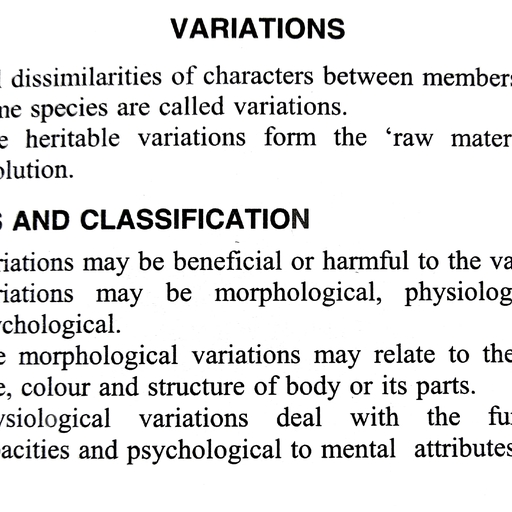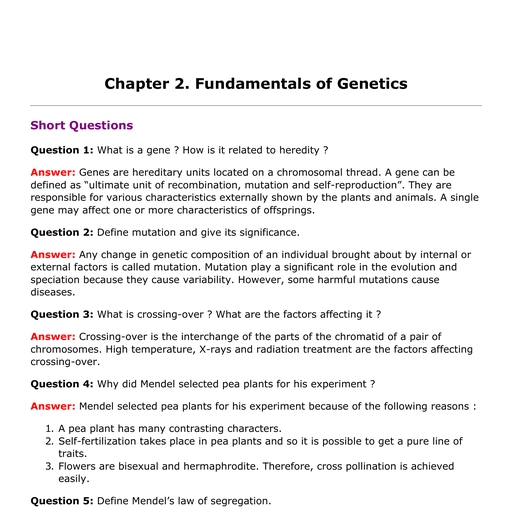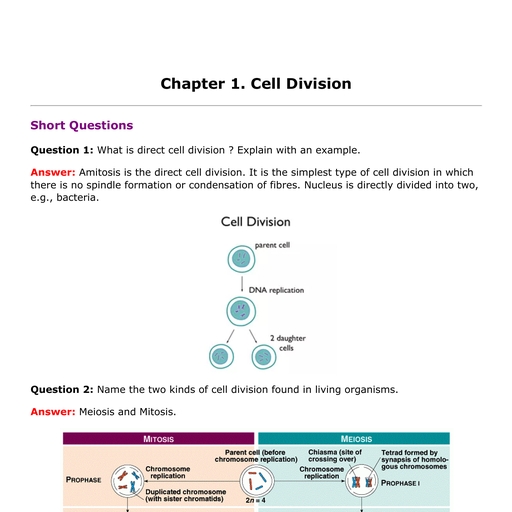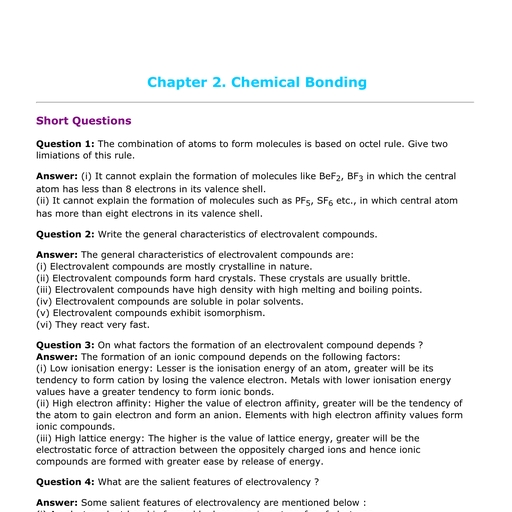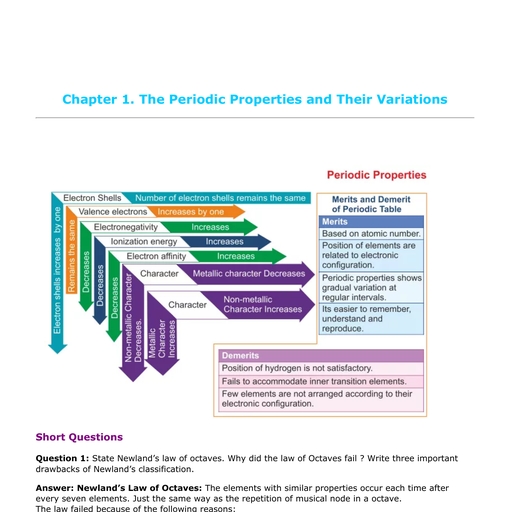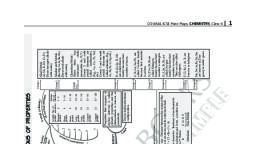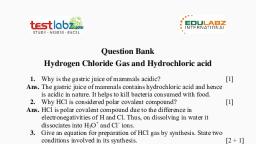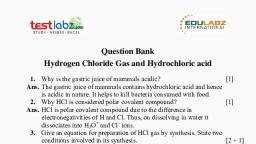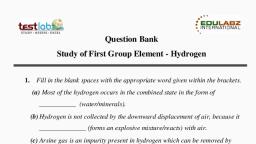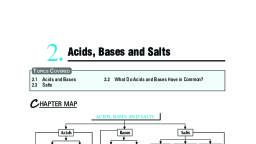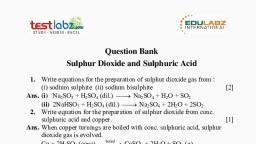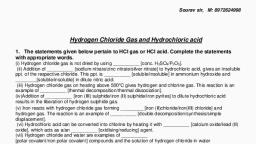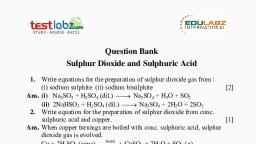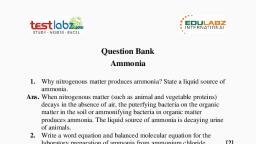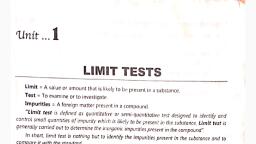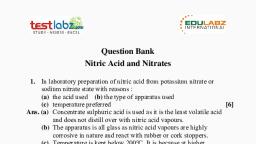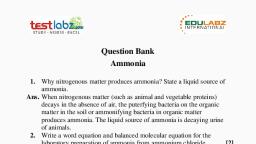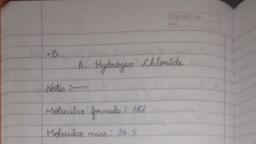Page 1 :
Question Bank, Hydrogen Chloride Gas and Hydrochloric acid, 1. Why is the gastric juice of mammals acidic?, [1], Ans. The gastric juice of mammals contains hydrochloric acid and hence, is acidic in nature. It helps to kill bacteria consumed with food., 2. Why HCl is considered polar covalent compound?, [1], Ans. HCl is polar covalent compound due to the difference in, electronegativities of H and Cl. Thus, on dissolving in water it, dissociates into H3O+ and Cl– ions., 3. Give an equation for preparation of HCl gas by synthesis. State two, conditions involved in its synthesis., [2 + 1], Diffused, 2HCl, Ans. H2 + Cl2 ⎯⎯⎯→, light, Conditions :, (i) The synthesis should be carried in diffused sunlight as the, reaction is highly explosive in direct sunlight., (ii) The gases should be slighty moist as moisture acts as catalyst., 4. In the laboratory preparation of HCl gas from sodium chloride, state,, why the following are preferred., (i) Conc. H2SO4 as reactant, (ii) Temp. of reaction mixture below 200°., (iii) Conc. H2SO4 as drying agent., [3], Ans. (i) Conc. sulphuric acid is a powerful oxidising agent and is least, volatile. Thus, when reaction mixture is heated, only HCl gas, passes over and not the vapours of sulphuric acid., (ii) If the temperature rises above 200°C, (a) Sodium bisulphate reacts with common salt to form sodium, sulphate. The sodium sulphate so formed fuses in glass, apparatus and renders it useless., Diffused, Na2SO4 + HCl, NaHSO4 + NaCl ⎯⎯⎯→, light, , Chemistry Class-X, , 1, , Question Bank
Page 2 :
(b) The apparatus may break., (iii) The concentrated sulphuric acid absorbs moisture from HCl gas, without chemically reacting with the gas and hence is a good, drying agent., 5. Why are conventional drying agent such as calcium oxide and, phosphorus pentoxide not used for drying moist HCl gas? Give, equations., [3], Ans. The drying agents react chemically with HCl and hence cannot be, used as shown by the equations below :, CaO + 2HCl –→ CaCl2 + H2O, 2P2O5 + 3HCl –→ POCl3 + 3HPO3, Phosphorus, oxy-chloride, , (meta phosphoric acid), , 6. Compare the density of HCl gas with air., [1], Ans. HCl gas is heavier than air as its density is 18.25, whereas that of the, air is 14.4., 7. Compare the solubility of HCl gas with water., [1], Ans. HCl gas is highly soluble in water. One volume of water at room, temperature can dissolve 452 volumes of HCl gas., 8. State, why HCl gas fumes in moist air., [1], Ans. The HCl gas being highly soluble in water, dissolves in the water, vapour present in air to form fine droplets of liquid hydrochloric, acid, which appear like fumes., 9. What does fountain experiment explain about the nature of HCl gas. [1], Ans. It shows that HCl gas is highly soluble in water., 10. State the colour changes in three different indicators in the presence, of HCl gas., Ans. (i) Moist blue litmus paper (or blue litmus solution) changes to red, colour., (ii) Methyl orange solution changes to pink colour., (iii) Phenolphthalein solution becomes colourless., , Chemistry Class-X, , 2, , Question Bank
Page 3 :
11. Give a balanced equation for the thermal dissociation of a solid, containing chloride ion., heat, ⎯⎯→, NH3 + HCl, Ans. NH4Cl ←⎯⎯, 12. State your observation when a rod dipped in ammonium hydroxide, solution is taken in the jar of HCl. Support your answer by a, chemical equation., [2], Ans. Dense white fumes are formed around the glass rod. It is because the, ammonia vapours on coming in contact with HCl gas form solid, ammonium chloride particles, which get suspended in the gas and, appear like dense white fumes., NH3 (g) + HCl (g) –→ NH4Cl (s), 13. How will you convert iron to iron (II) chloride? Support your, answer by a chemical equation., [2], Ans. Take about 100 ml of dil. HCl in a beaker and to it add excess of, iron filings. Stir the mixture till the reaction stops., Fe + 2HCl (dil.) –→ FeCl2 + H2, Filter the reaction mixture. The clear light green filtrate is of iron, (II) chloride., 14. Explain the term constant boiling mixture., [2], Ans. A mixture of a chemical in water (say HCl in water) in certain, proportion, such that on boiling the chemical and water are expelled, out in the form of vapours in same proportion is called constant, boiling mixture. Such a mixture cannot be concentrated by boiling., 15. State why cannot be dilute hydrochloric acid concentrated beyond, certain concentration on boiling., [2], Ans. When the concentration of HCl gas in water is 22.2% by weight, it, forms a constant boiling mixture. At this concentration, if dilute, hydrochloric acid is heated then water and HCl vaporise in the same, proportion by weight and hence dilute hydrochloric acid cannot be, concentrated., , Chemistry Class-X, , 3, , Question Bank
Page 5 :
Name two soluble nitrates which can be converted into insoluble, chlorides by the use of dilute HCl. Support your answer by chemical, equations., Ans. (i) Silver nitrate solution on treating with dilute HCl, forms, insoluble silver chloride, AgNO3 (sol) + HCl –→ HNO3 + AgCl (s), (ii) Lead nitrate solution on treating with dilute HCl forms insoluble, lead chloride, Pb(NO)3 (sol) + 2HCl –→ 2HNO3 + PbCl2 (s), 21. How does silver nitrate solution react with sodium chloride solution., State your observations when above mixture is treated with excess, of ammonium hydroxide. Support your answer by chemical, equations., [4], Ans. When sodium chloride solution is treated with silver nitrate solution, it forms a curdy white ppt. of silver chloride., NaCl (sol) + AgNO3 (sol) –→ NaNO3 (sol) + AgCl (s), When excess of ammonium hydroxide is added to the above, reaction mixture, the silver chloride ppt. dissolves to form a clear, solution of diamine silver chloride., AgCl + 2NH4OH –→ Ag(NH3)2Cl + 2H2O, 22. The statements given below pertain to HCl gas or HCl acid., Complete the statements with appropriate words. [1 mark of each blank space], (i) Hydrogen chloride gas is not dried by using __________, [conc H2SO4/P2O5]., (ii) Addition of __________ [sodium nitrate/zinc nitrate/silver, nitrate] to hydrochloric acid, gives an insoluble ppt. of the, respective chloride. This ppt. is __________ [soluble/insoluble], in ammonium hydroxide and __________ [soluble/insoluble] in, dilute nitric acid., (iii) Hydrogen chloride gas on heating above 500°C gives hydrogen, and chlorine gas. This reaction is an example of __________, [thermal decomposition/thermal dissociation]., , 20., , Chemistry Class-X, , 5, , Question Bank
Page 6 :
(iv) Addition of __________ [iron (III) sulphide/iron (II), sulphide/iron pyrities] to dilute hydrochloric acid results in the, liberation of hydrogen sulphide gas., (v) Iron reacts with hydrogen chloride gas forming __________, [iron (II) chloride/iron (III) chloride] and hydrogen gas. The, reaction is an example of __________ [double, decomposition/synthesis/simple displacement]., (vi) Hydrochloric acid can be converted into chlorine by heating it, with __________ [calcium oxide/lead (II) oxide], which acts as, a/an __________ [oxidising/reducing] agent., (vii) Hydrogen chloride and water are examples of __________, [polar covalent/non polar covalent] compounds and the solution, of hydrogen chloride in water __________ [contains/does not, contain] free ions., (viii) An aqueous solution of HCl gas is named __________, [aquafortis/oil of vitriol/muriatic acid]., (ix) The salt obtained when rock salt reacts with conc. sulphuric acid, below 200°C is a/an __________ [acid/normal] salt., (x) In the preparation of HCl acid from HCl gas, a funnel, arrangement provides __________ [more/less] surface area for, the absorption of gas., Ans. (i) P2O5, (ii) silver nitrate, soluble, insoluble, (iii) thermal dissociation (iv) iron (II) sulphide, (v) iron (II) chloride, simple displacement, (vi) lead (II) oxide, oxidising, (vii) polar covalent, contains, (viii) muriatic acid, (ix) acid, (x) more, , Chemistry Class-X, , 6, , Question Bank
Page 8 :
Choose the chemicals from the letters A, B, C, D and E, which, match the descriptions below, B. AgCl, A. NH4Cl, D. PbCl2, C. Ag(NH3)2 Cl, E. FeCl2, (i) A salt which is soluble in hot water, but insoluble in cold water., (ii) A salt which is insoluble in nitric acid, but soluble in ammonia, solution., (iii) A salt obtained when a basic gas reacts with HCl gas., (iv) A salt obtained by the action of active metal with dil. HCl., (v) A salt obtained by dissolving insoluble metallic chloride in, excess of ammonium hydroxide., (ii) B. AgCl, Ans. (i) D. PbCl2, (iii) A. NH4Cl, (iv) E. FeCl2, (v) C. Ag(NH3)2 Cl, 26. A colourless gas G fumes strongly in the air. The gas gives dense, white fumes when a glass rod dipped in ammonia solution is held, near the gas. Answer the following questions :, (i) Name the gas G., (ii) Name two chemicals used in the preparation of the gas G., (iii) Write the chemical equations for the reaction of the chemicals, named in (ii) when :, (a) The reaction mixture is not heated., (b) The reaction mixture is heated above 100°C., (iv) Why does the gas G fume strongly in air ?, (v) Why does the gas G form dense white fumes with ammonium, hydroxide ?, [5], Ans. (i) The gas G is hydrogen chloride gas., (ii) The chemicals are (i) sodium chloride (ii) conc. sulphuric acid, Without, NaHSO4 + HCl (g), (iii) (a) NaCl + H2SO4 (conc.) ⎯⎯⎯→, Heating, 25., , Heat, → Na2SO4 + HCl (g), (b) NaCl + NaHSO4 ⎯⎯⎯, , Chemistry Class-X, , 8, , Question Bank
Page 9 :
(iv) It is because the HCl gas is extremely soluble in water. Thus,, the gas dissolves in water vapour present in the air to form tiny, droplets of hydrochloric acid, which appear in the form of, fumes., (v) The HCl gas reacts with vapours of ammonium hydroxide to, form very fine solid particles of ammonium hydroxide which, are white in colour. These white particles of solid ammonium, hydroxide appear in the form of white fumes., 27. State the products formed and write chemical equations when the, following substances are treated with hydrochloric acid., (a) Calcium carbonate, (b) Magnesium hydrogen carbonate, (c) Ferric hydroxide (d) Copper oxide, (e) Sodium nitrite, (f) Zinc sulphide, (g) Aluminium metal (h) Potassium sulphite, (i) Potassium nitrate, [2 each], Ans. (a) When calcium carbonate is treated with dilute hydrochloric, acid, the products are :, (i) calcium chloride, (ii) carbon dioxide gas and (iii) water, CaCO3 + 2HCl (dil.) —→ CaCl2 + CO2 (g) + H2O, (b) When magnesium hydrogen carbonate is treated with dilute, hydrochloric acid, the products are:, (i) magnesium chloride, (ii) carbon dioxide gas and (iii) water., Mg (HCO3)2 + 2HCl (dil.) —→ MgCl2 + 2CO2 (g) + 2H2O, (c) When ferric hydroxide is treated with dilute hydrochloric acid,, the products are : (i) ferric chloride and (ii) water., Fe(OH)3 + 3HCl (dil.) —→ FeCl3 + 3H2O, (d) When copper oxide is warmed with dilute hydrochloric acid, the, products are :, (i) copper chloride, (ii) water., Warm, → CuCl2 + H2O, CuO + 2HCl (dil.) ⎯⎯⎯, , Chemistry Class-X, , 9, , Question Bank
Page 11 :
29. Give two tests for HCl gas., [2], Ans. (i) It forms dense white fumes when a glass rod dipped in ammonia, solution, is held near it., (ii) It forms curdy white precipitate when passed through a solution, of silver nitrate., 30. Give two tests for hydrochloric acid., [2], Ans. 1. When manganese dioxide is boiled with conc. hydrochloric, acid, greenish-yellow gas chlorine is evolved., 2. When treated with silver nitrate solution, it forms curdy white, precipiate, which is soluble in excess of ammonium hydroxide, solution., 31. State four uses of hydrochloric acid., [2], Ans. Uses of hydrochloric acid :, 1. It is used in the manufacture of glucose from starch., 2. It is used for the extraction of glue from bones., 3. It is used in the manufacture of silver chloride, widely used in, photography., 4. It is used in the manufacture of dyes, drugs and paints., 32. (i) Hydrogen is burnt in a greenish-yellow gas A then another gas, B is formed. The gas B gives dense white fumes with ammonia, liquor. Name the gases A and B., [2], (ii) Write chemical equations in support of your answer in 32 (i). [2], (iii) Burning sodium is taken in the gas B, when it forms a salt C and, another colourless gas D. The salt solution of C gives a curdy, white precipitate with silver nitrate solution. The white, precipitate is soluble in excess of ammonium hydroxide., (a) Name the salt C., [1], (b) Name the gas D., [1], (c) Write the chemical equations for the reaction between, (1.) B and sodium (2.) C and silver nitrate, (3.) white precipitate and ammonium hydroxide, [3], , Chemistry Class-X, , 11, , Question Bank
Page 12 :
Ans. (i) A is chlorine gas., B is hydrogen chloride gas., (ii) H2 + Cl2 —→ 2HCl, NH4OH + HCl —→ NH4Cl + H2O, (iii) (a) The salt C is sodium chloride, (b) The gas D is hydrogen gas., (c) (1) 2Na + 2HCl —→ 2NaCl + H2 (g), (2) NaCl + AgNO3 —→ AgCl + NaNO3, (3) AgCl + 2NH4OH —→ [Ag (NH3)2Cl] + 2H2O, 33. Describe tests (other than electrolysis) to prove that hydrochloric, acid contains :, (i) hydrogen gas, (ii) chlorine gas, Ans. (i) To show the presence of hydrogen in hydrochloric acid., To the dilute solution of HCl, add a few pieces of magnesium, and collect the gas evolved. Test the gas with a burning splint. It, is observed that the gas burns with a pop sound. This proves that, hydrogen gas is evolved and hence the hydrochloric acid, contains hydrogen gas., (ii) To show the presence of chlorine in hydrochloric acid., To about 10 cm3 of conc. hydrochloric acid, add 2g of, manganese dioxide. Boil the reaction mixture. It is observed that, a greenish yellow gas is given out. Test the gas with moist, potassium iodide paper. The paper will turn blue. This confirms, that chlorine gas is given out and hence hydrochloric acid, contains chlorine., 34. How can you distinguish between HCl gas and carbon dioxide gas, by ONE test ?, [2], Ans. Hold a glass rod moistened with ammonium hydroxide in either of, the gases. In case of HCl gas, dense white fumes are formed but not, in case of carbon dioxide gas., , Chemistry Class-X, , 12, , Question Bank
Page 13 :
Explain, why silver nitrate crystals are dissolved in distilled water, and not in tap water in order to prepare a solution of silver nitrate as, a laboratory reagent., [4], Ans. Tap water always contains some amount of dissolved sodium, chloride. Thus, when the solution of silver nitrate is prepared in tap, water, it reacts to form curdy white precipitate of silver chloride., AgNO3 + NaCl —→ AgCl + NaNO3, To prevent the above chemical reaction, the solution of silver nitrate, is prepared in distilled water., 36. (a) Name two gases which react chemically to form a solid., [1], (b) Name a metallic chloride which is soluble in excess of, ammonium hydroxide., [1], (c) By giving a reason explain why dilute HCl connot be, concentrated by simple distillation., [1], Ans. (a) The two gases which react chemically to form a solid are :, (i) ammonia gas (ii) hydrogen chloride gas., (b) Silver chloride is soluble in excess of ammonium hydroxide., (c) When the concentration of hydrochloric acid is 22.2% by, weight, it forms a constant boiling mixture. Now if it is, distilled, the water and hydrochloric acid will distil in the same, proportion as constant boiling mixture. Thus, the distillate, cannot be more concentrated than the hydrochloric acid in the, distillation flask., 35., , Chemistry Class-X, , 13, , Question Bank






